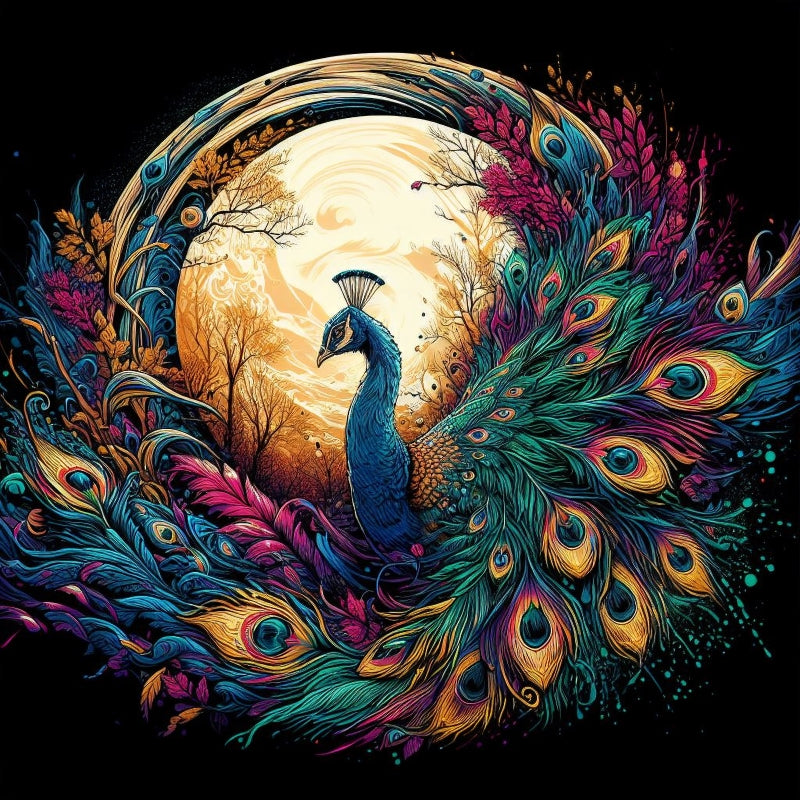
Significance of Peacocks in India: Historically and Culturally
Share
The Indian peacock, or Pavo cristatus, is not only a bird of stunning beauty but also a creature steeped in rich cultural and historical significance in India. Declared the national bird of India in 1963, the peacock symbolizes grace, beauty, and the vibrant spirit of Indian heritage. This blog post explores the multifaceted significance of peacocks in India, examining their historical roots, cultural symbolism, and ecological importance.
- Historical Context
The peacock has been an integral part of Indian culture for centuries. Historical references to this magnificent bird can be found in ancient texts and scriptures. The earliest mentions date back to the Vedic period, where the peacock is celebrated for its beauty and grace. It has been depicted in various forms of art, literature, and architecture throughout India's history.
Royal Associations
Peacocks have long been associated with royalty and nobility. During the Mughal era, they were prominently featured in art and architecture. The Mughal emperors, particularly Shah Jahan, incorporated peacock motifs into their palaces and gardens. The famous Peacock Throne, commissioned by Shah Jahan for his court, was a symbol of imperial power adorned with precious gems and intricate designs inspired by the peacock's plumage.
- Cultural Significance
Peacocks hold a special place in Indian mythology, religion, and folklore.
Religious Symbolism
In Hinduism, the peacock is closely associated with several deities. One of the most notable associations is with Lord Krishna, who is often depicted wearing a crown adorned with peacock feathers. According to legend, when Lord Krishna played his flute, peacocks danced joyfully around him, showcasing their vibrant plumage as a tribute to his music. This connection emphasizes the peacock's role as a symbol of love and joy. Additionally, the peacock is linked to Saraswati, the goddess of wisdom, learning, and the arts. In this context, the peacock represents knowledge and creativity. Its graceful movements and beautiful feathers symbolize artistic expression and intellectual pursuits.
Festivals and Celebrations
Peacocks are celebrated during various festivals across India. During the monsoon season, their courtship displays are seen as a sign of fertility and prosperity. The arrival of rain is often welcomed with festivities that include dance performances inspired by the peacock's movements. In some regions, traditional dances mimic the graceful movements of peacocks, celebrating their beauty while invoking blessings for good harvests. The sight of a peacock dancing during rain is considered auspicious and is believed to bring good fortune.
- Artistic Representation
The peacock has inspired countless works of art throughout Indian history:
- Textiles: The peacock motif is prevalent in traditional textiles such as silk sarees and embroidered fabrics. Designers often incorporate intricate depictions of peacocks into their creations, reflecting both cultural heritage and artistic expression. For example, Kanjivaram sarees frequently feature elegant peacock designs that enhance their beauty.
- Architecture: Peacocks are also represented in architectural designs across India. The intricate carvings found in temples often depict peacocks alongside other symbols of divinity. Notable examples include the Hawa Mahal in Jaipur, which features elements inspired by the crown of Lord Krishna adorned with peacock motifs.
- Ecological Importance
Beyond their cultural significance, peacocks play an important role in their ecosystems:
- Biodiversity: As omnivorous birds, Indian peafowls contribute to maintaining ecological balance by controlling insect populations and dispersing seeds through their feeding habits. Their presence indicates a healthy ecosystem where diverse flora and fauna coexist.
- Habitat: Peafowls inhabit various environments across India—from forests to grasslands—demonstrating adaptability to different habitats. They are often found near water sources where they can forage for food while avoiding predators.
- Conservation Status
Despite their cultural prominence, Indian peafowls face several challenges that threaten their populations:
- Habitat Loss: Urbanization and agricultural expansion have led to habitat destruction for many wildlife species, including peafowls. As forests are cleared for development or agriculture, these birds lose their natural habitats.
- Human-Wildlife Conflict: As human populations grow near peafowl habitats; conflicts arise when these birds raid crops or gardens in search of food. Farmers may retaliate against these birds to protect their livelihoods.
The Indian Peacock is currently classified as "Least Concern" on the IUCN Red List; however, continued conservation efforts are essential to protect their habitats from further degradation.
- Legal Protection
Recognizing the cultural significance of the Indian peacock and its role in maintaining biodiversity, it is protected under the Indian Wildlife (Protection) Act of 1972. This legislation prohibits hunting or harming these birds while promoting conservation efforts aimed at preserving their populations.
- Peacocks in Modern Culture
In contemporary India, the peacock continues to be celebrated as a symbol of beauty and grace:
- Tourism: Peafowls attract tourists to national parks and wildlife sanctuaries where they can be observed in their natural habitats. Birdwatching tours often highlight these magnificent creatures as part of India's rich wildlife offerings.
- Media Representation: The image of the peacock is commonly used in advertisements, films, and fashion shows to evoke feelings of elegance and cultural pride. Its association with beauty makes it an appealing motif for various forms of media.
- Educational Importance
The Indian peacock serves an educational purpose beyond its aesthetic appeal:
- Wildlife Education: Schools and educational programs use the peacock as a focal point for teaching students about biodiversity conservation and environmental stewardship. By learning about this national symbol, students gain an appreciation for wildlife protection efforts.
- Cultural Awareness: Understanding the significance of the peacock helps foster respect for India's diverse cultural heritage while promoting awareness about traditional practices that honor nature.
Conclusion
The significance of the Indian peacock transcends its stunning appearance; it embodies a rich tapestry of history, culture, spirituality, and ecological importance within India. Revered as symbols of beauty and grace across various traditions—peacocks continue to inspire awe among people from all walks of life.
As we recognize why this magnificent bird holds such an esteemed place within our hearts—let us commit ourselves not only to safeguarding its habitats but also ensuring that future generations will continue marveling at these incredible beings roaming freely across our landscapes! In celebrating this national symbol—may we also honor our responsibility toward conserving nature for future generations while fostering coexistence strategies that benefit both humans and wildlife alike!
Citations:
[1] https://ikaki.in/bagh/peacock/
[2] https://www.travellingcamera.com/2024/04/the-majestic-indian-peacock.html
